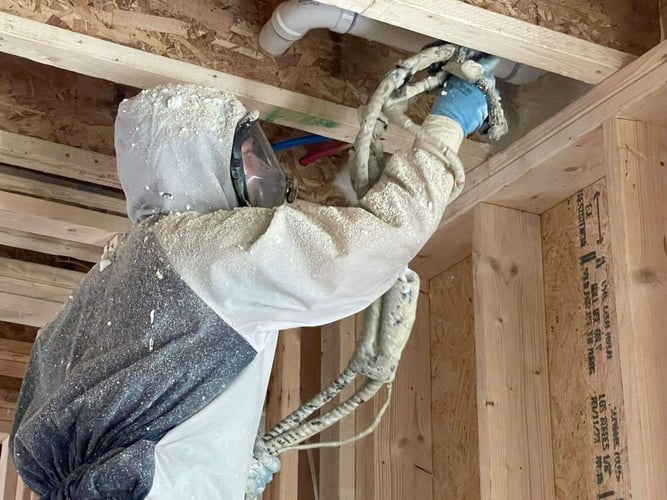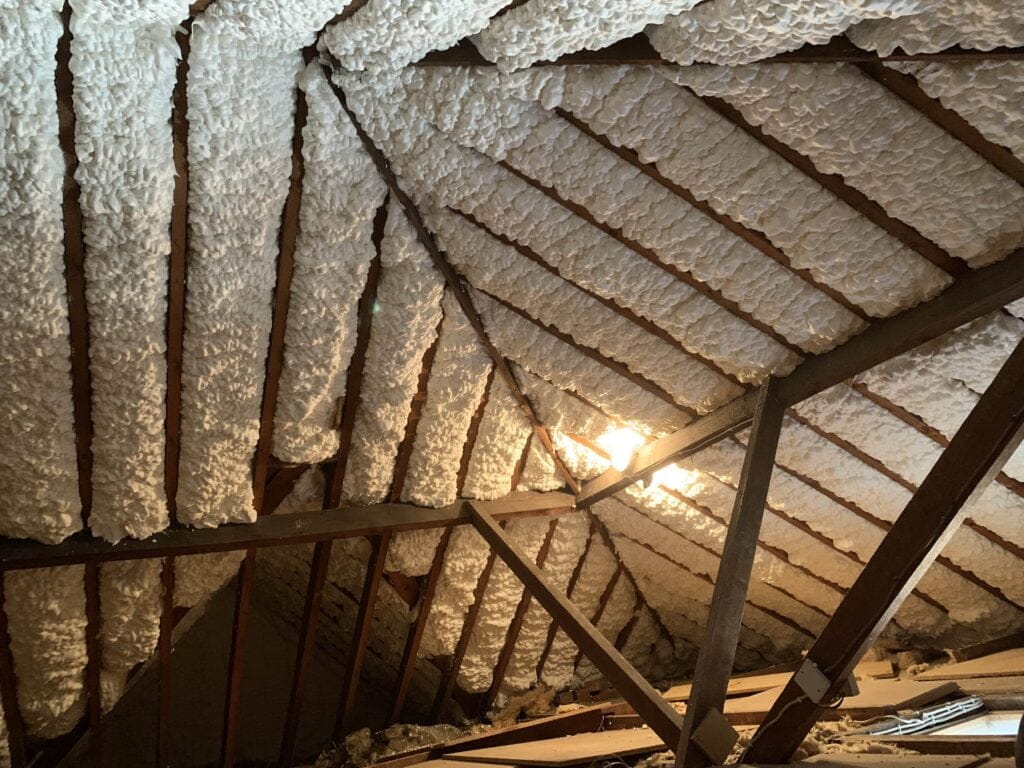Understanding the Benefits of Using Spray Foam for Insulation Projects
Understanding the Benefits of Using Spray Foam for Insulation Projects
Blog Article
Spray Foam: The Ultimate Option for Air Sealing and Insulation
Spray foam insulation has actually become a leading solution for effective air sealing and thermal insulation, providing a special mix of residential properties that establish it in addition to traditional methods. Its ability to expand and fill gaps makes it particularly reliable in protecting against air leak, which can significantly influence power performance. Nevertheless, comprehending the full scope of its benefits, installment procedures, and comparisons with various other insulation kinds is crucial for making informed choices. As we discover these elements, the ramifications for both new building and constructions and retrofits come to be progressively considerable. What elements should affect your selection?
What Is Spray Foam?
Spray foam is a flexible insulation material that incorporates the concepts of air sealing and thermal resistance to improve energy performance in buildings. Made up mainly of polyurethane or other comparable substances, spray foam is applied as a fluid that increases upon contact with surface areas, developing a strong, continuous layer of insulation. This special property enables it to load gaps, fractures, and spaces that typical insulation materials might forget, providing a remarkable air seal.
There are 2 main sorts of spray foam: open-cell and closed-cell. Open-cell spray foam is lighter and more flexible, using superb sound absorption and a lower R-value per inch - Spray Foam. In contrast, closed-cell spray foam is denser, offering a higher R-value, wetness resistance, and included architectural honesty to building components
The application process typically involves specific tools, making certain a seamless application that follows different substratums, consisting of concrete, steel, and timber. This flexibility makes spray foam ideal for both brand-new building and constructions and retrofitting existing frameworks. Its capacity to develop an impermeable obstacle considerably adds to minimizing energy consumption and enhancing indoor air quality, thus making it a favored choice among contractors and house owners alike.
Advantages of Spray Foam Insulation
One of the most substantial benefits of spray foam insulation is its exceptional ability to develop a constant air barrier, which effectively decreases energy loss. Unlike traditional insulation materials, spray foam increases to fill up spaces and cracks, making sure that air leakage is considerably decreased. This particular not just enhances energy effectiveness however additionally leads to decrease utility bills in time.
In addition, spray foam insulation supplies exceptional thermal resistance, adding to a more secure indoor environment. Its high R-value per inch permits effective insulation in constrained spaces, making it suitable for attics, walls, and crawl rooms. Additionally, the moisture-resistant homes of spray foam aid prevent mold and mold development, advertising healthier living conditions.
An additional vital advantage of spray foam insulation is its sound-dampening top qualities (Spray Foam). It effectively lowers sound transmission in between areas, developing a quieter and more comfortable home environment. The longevity of spray foam also stands apart, as it does not sag or resolve with time, maintaining its performance throughout its lifespan
How Spray Foam Works
Comprehending exactly how spray foam insulation works is necessary for valuing its effectiveness in air sealing and thermal resistance. Spray foam insulation is composed of 2 primary elements: isocyanate and polyol resin. When these parts are combined, they undertake a chemical response that creates the product to increase swiftly, additional resources creating a thick foam that loads voids, splits, and tooth cavities.
As the foam broadens, it complies with surface areas, developing a closed seal that dramatically minimizes air infiltration. This particular makes spray foam insulation extremely effective at avoiding view it drafts and dampness penetration, which can lead to power loss and damage over time. Furthermore, the closed-cell variant of spray foam supplies remarkable thermal resistance due to its inflexible structure, effectively decreasing warm transfer.
The distinct homes of spray foam permit it to satisfy irregular surface areas, making sure detailed coverage and a seamless obstacle. Because of this, spray foam insulation not just improves power effectiveness however also adds to enhanced indoor air top quality by minimizing the accumulation of pollutants and irritants. Ultimately, comprehending the technicians behind spray foam highlights its role as a remarkable selection for insulation and air sealing in both property and business applications.
Installment Refine Summary

Prior to installation, the area has to be effectively cleansed and prepped, ensuring that surfaces are devoid of dust, wetness, and debris. This step is essential since pollutants can endanger bond and total efficiency. When the area is prepared, the application involves mixing the two components of the spray foam, which expands upon contact and loads spaces successfully.
Trained professionals should conduct the installment, using specific equipment to guarantee uniform insurance coverage and optimum density. Safety safety measures, including wearing safety gear and guaranteeing proper air flow, are essential during this procedure. After application, the foam normally remedies rapidly, developing a solid barrier that boosts energy efficiency.
Contrasting Spray Foam to Typical Insulation
When assessing insulation alternatives, hop over to these guys spray foam insulation stands out in comparison to standard materials such as fiberglass and cellulose. Unlike fiberglass and cellulose, which can enable air seepage, spray foam expands upon application, filling up gaps and gaps to produce a closed seal.
In addition, spray foam provides a higher R-value per inch than standard insulation kinds, offering more efficient thermal resistance in a thinner account. This characteristic is particularly helpful in rooms with limited cavity depth. Spray foam is immune to dampness and mold growth, which can be a significant issue with cellulose and fiberglass, especially in damp atmospheres.
Nonetheless, spray foam insulation commonly carries a greater ahead of time price than its typical equivalents. Home owners have to consider this first financial investment versus long-lasting energy cost savings and performance benefits. Ultimately, while both insulation types serve their function, spray foam emerges as a more advanced service for modern insulation demands, specifically in regards to air sealing and thermal efficiency.

Final Thought
In summary, spray foam insulation represents a highly efficient remedy for accomplishing optimal air sealing and thermal resistance. Its special properties, consisting of dampness resistance and noise dampening, make it suitable for different applications in both new buildings and retrofitting tasks (Spray Foam). The preliminary expenses may be higher compared to conventional insulation materials, the long-term benefits, such as significant energy savings and boosted interior air top quality, warrant the financial investment and emphasize its worth in contemporary building practices.
Spray foam insulation has actually arised as a leading option for efficient air sealing and thermal insulation, using a special mix of properties that establish it apart from standard techniques.Spray foam is a versatile insulation material that incorporates the concepts of air sealing and thermal resistance to enhance energy performance in structures.When examining insulation choices, spray foam insulation stands out in comparison to typical products such as fiberglass and cellulose. Eventually, while both insulation types offer their objective, spray foam emerges as a more innovative option for modern insulation demands, specifically in terms of air sealing and thermal efficiency.
In recap, spray foam insulation represents a highly reliable service for achieving optimal air securing and thermal resistance.
Report this page